Mechanics is the body of knowledge that deals with the relationships between forces and the motion of points through space, including the material space. This book is devoted to the basic variational principles of mechanics. Readership includes mathematicians, physicists, and engineers interested in geometrical methods in mechanics, assuming a background in calculus, linear algebra, some classical analysis and point set topology. The central part deals with thermo-elastic bodies with heat conduction and viscosity, including ideal dissipation less bodies. A surprising variety of phenomena can be modeled within this framework. The main ideas can be transferred into more complicated theories of materials with memory or microstructure. A large portion is an extension of Gibbs’ ideas to bodies of general symmetry by the methods of the calculus of variations.
The book begins with analysis which should be treated as a resource chapter. The concept of the rate of change of a vector plays an important role throughout mechanics. Analysis as well as geometrical treatment of vectors are presented for visualization of the dynamical motions. The book may be used in graduate and senior undergraduate dynamics courses in engineering, applied mathematics and physics departments, or it may also serve as a self-study reference text. This book provides a basic practical introduction to engineering mechanics and is written specifically for those students who need a thorough grounding in the subject to participate fully in their engineering course.





There are no reviews yet.